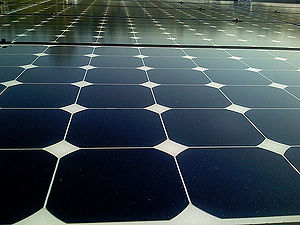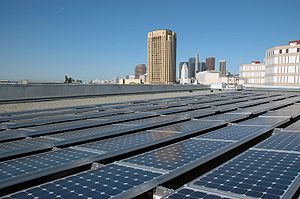Course:ECON371/UBCO2010WT1/GROUP8/Article3
Summaries

The first article describes the development of a breakthrough in solar cell technology by scientists at Stanford University. The technology and materials employed succeeds in keeping light within the solar cell for a longer period of time than was previously possible. The metaphor of a mouse in a wheel was chosen to illustrate the benefit of the concept; such that the longer the mouse is on the wheel and running, the more power could be extracted from the process. The scientists have achieved this by using the thinner, organic-based polymer films and arranging them in specific layers. As opposed to traditional silicon-based cells, the use of very thin polymers allows sunlight to be absorbed up to 10 times more efficiently. This strategy, coupled with a process whereby these films are essentially “roughed-up” to reflect light in many different directions, has allowed the sunlight to ricochet within the solar cell. The technique, called “light trapping”, aims to squeeze as much energy from the light as possible, thereby increasing the efficiency of the cell. Obviously, the more efficient the materials are at absorbing the light, the more efficient the conversion of light to energy will be. Additionally, the use of thin organic polymer films means less of these are needed to fabricate the cells, which translates to cost savings. Better still, these are also less expensive to make than silicon, therefore material costs are less as well.
The second article introduces the latest advancements in photovoltaic materials - those used in the fabrication of solar cells. As compared to silicon-based semiconductors, these new organic types allow the energy carrying particles within the cell to travel a thousand times farther. If these are allowed to travel farther, the overall performance of the cell is improved. Costs associated with building solar cells may fall, as less materials may be used to move these energy carrying particles over the same distance. These organic semiconductors may be put to other uses as well, such as in video displays. One advantage is that they can be manufactured in large sheets of plastic. The use of inexpensive plastics will undoubtedly make solar cells much less expensive than their silicon-based ancestors. As opposed to silicon cells, which require high-temperature or vacuum processing, organic materials are fabricated much simpler with chemical reactions in a solution. However, the organic compounds have certain disadvantages. They are very sensitive to moisture and oxidization, and degrade from extended exposure to ultraviolet light. Although the technology is still developing, this new type of carbon-based polymer may one day propel the solar cell industry further ahead in becoming a significant alternate energy source.
Analysis

Undeniably, both developments are very important milestones on the way to increasing the efficiency of solar cell technology. The reason I chose to analyze these two articles lies in my curiosity in questioning which one of these is more suited to the ultimate goal of making solar power an economically viable source of energy. Unfortunately, the articles do not provide enough detail to be able to accurately assess and answer such a question. But if we needed to choose between both programs, investing considerable amounts of time and resources into developing only one, which would it be?
Consider the position of a government agency that has a set budget and must make the difficult choice of funding only one of these programs. The agency would grant a one-time lump sum grant dedicated to solar power development. Rutgers' scientists have not yet fully developed their technology, and would need a substantial investment to get off the ground. However, they promise significant cost savings on future solar cell production as a result of their technology. Stanford's program requires less initial funding, but they guarantee continuous improvements in efficiency as a result of growing their technology.
This agency could conduct a benefit-cost analysis for each option and choose the program that exhibited the greatest net benefit. This poses a challenging problem, as benefits resulting from any of these developments are uncertain and notoriously difficult to measure. To account for benefits, they shall be determined as incremental advancements in their respective technologies that can be reported to the agency. It is reasonable to assume that solar power will play an important role in the country's renewable energy portfolio, if you will, and such advancements translate to benefits for the country. For the sake of a benefit-cost analysis, a time frame of five years is chosen for the assessment of both projects. Judging by what we read in the article, the Rutgers scientists would spend their first year furthering their research and development of their technology, during which no measurable benefits can be accrued. After they've discovered how to properly apply their technology, a steady growth in benefits occurs for each successive year. On the other hand, the scientists at Stanford can already apply their technology and are making advancements at a steady rate every year. Which program should the agency choose?
Assuming that the benefits could be valued against the initial investments, and that these could be discounted to find their present values, the agency would choose the option that exhibited the highest net benefits. But this analysis ignored the third option available to the agency: One in which both programs were given a portion of the available funds. The net benefits of such a program would then be compared against these results. In such a scenario, whenever governments are to choose between multiple programs, the most efficient allocation of resources is one where the net benefits produced by the total budget are maximized. It is important to note that there is always a risk that one of these technologies becomes obsolete, or another technology - such as wind power - will become the dominant force in the future. These uncertainties are not beyond a measure of calculation, and probabilities of such events occurring can be factored into the equation. If the agency can gather data on the probability that another breakthrough in solar cell technology will negate these developments - which can be measured, for example, by considering the time it took for silicon-based cells to become obsolete - then an expected value of an investment can be considered.
Although this example illustrates how a government may make an economic decision to pursue one avenue or another, or both, it ignores the implication of this decision on the environment. The Stanford program strives for extracting more energy from the same amount of sunlight, a more intelligent and responsible use of the resource, and a more efficient way of using the materials it requires. They seem to project a focus on the goal of a less wasteful solar cell. Less materials need to be used in the fabrication of the cell and in the resulting panel that houses it. The thin films are not creating more bulk in the end product, but rather they are allowing the technology to grow as a better product. In contrast, the Rutgers' program seems to be focused on the bottom line; cheaper materials, cheaper plastics, and giant sheets of semiconductors for video displays. They romanticize this "bigger, faster, cheaper" point of view that promotes a mass-produced version of a product that boasts a deplorable lifespan. The degradation of the organic material when exposed to ultraviolet light - which seems comical when considering its very purpose is to be exposed to sunlight - indicates a penchant for being disposable and very cost-ineffective. Combine that with a high sensitivity to atmospheric moisture and the danger of oxidization, the idea of incorporating this technology into inexpensive non-recyclable plastics seems to promote consumption, not sustainability. Could the agency have determined the value of costs and benefits of a program's technology that hasn't even been developed yet? Although such an economic decision as was presented above may do its best to incorporate such factors into its decision-making process, we must remain wary of the indirect impacts to the environment that may have escaped valuation.
Prof's Comments
Interesting slant, discussing how a CBA would be conducted. Using the context of what we are learning in class, some reference to abatement costs would have been good. Solar power is an example of an abatement technology, when one considers it in the overall market for energy. Reducing the cost of solar reduces the cost of abating emissions. Your comparison points out that one of the two technologies may be less effective as an abatement technology than the other, in part because the overall impacts are not that small.
I like your last point about organic solar panels. How is this stuff going to stand up against damaging conditions in the environment? I presume the engineers are considering this, but good to raise the question.